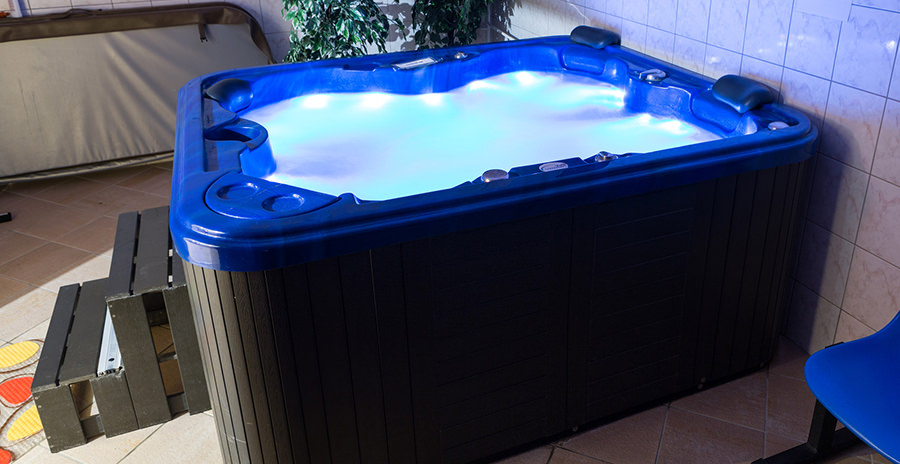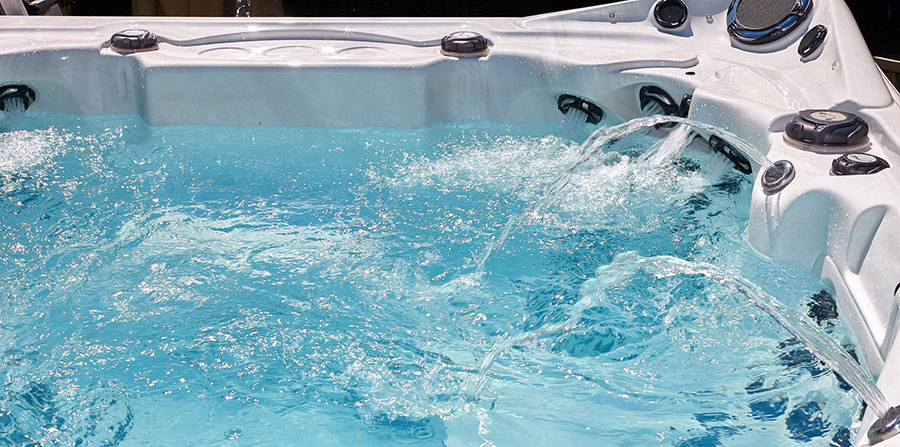
Having a hot tub inside is an appealing idea and using either the garage or the basement can often be the obvious choice. But what are the pros and cons of putting a hot tub in the garage or basement? Are there any special considerations to bear in mind and what problems might you face? I decided to do some research and this is what I found out:
So, can I put a hot tub in the garage or basement? You can put a hot tub in a garage or basement but you will need to think about how you will get water into the hot tub, how you will drain it and also make sure that the garage or basement is adequately ventilated.
Having an indoor hot tub comes with many advantages. The main one has to be that you are not constantly at the mercy of the weather and you will be able to comfortably soak in the hot tub whether it’s raining, snowing, hot or cold outside. You will also be able to use the hot tub more easily during the evening as well when it’s dark.
The other big plus that naturally follows on from this is that the hot tub will use less energy to keep at working temperature as well. Assuming that the temperature inside your house is generally higher than outdoors then your energy bills will be significantly lower than if the hot tub was outside.
You can also enjoy greater levels of privacy inside. If you don’t feel completely comfortable in your garden, or your garden is overlooked by neighboring houses then an indoor hot tub could be just the solution you are looking for.
Many indoor hot tub owners have the hot tubs in a sunroom or in a conservatory but, if this isn’t a possibility then a basement or a garage may very well be the next best thing. Basements and garages are usually relatively roomy and have solid concrete floors that will be suitable for supporting the weight of the hot tub. They also generally have electrical connections and may even have their own water supply.
Let’s have a more detailed look at some of the things you will need to think about if you want your hot tub to go in your basement or garage.

Planning permission – Generally speaking you won’t need planning permission for a hot tub inside or out but there could be some exceptions. If you rent your home then obviously you will need to discuss your plans with your landlord as well.
Where you might run into issues is if you do some sort of conversion in either the basement or the garage. If you start to add party walls, or line the walls with cladding or the room technically has a change of usage with the addition of permanent fixtures or fittings then you may have to take planning or building regulations into consideration.
The rules and regulations will be different according to where you live so, if you are in any doubt at all your should contact the appropriate department before going ahead.
Measure the space – First of all you need to make sure that you have enough room for the hot tub. Generally speaking, you will need to allow enough space for the footprint of the hot tub plus about a foot or so all round to allow room for maintenance.
Bear in mind that you may also want to have space for a towel rail, maybe a chair or two, steps for getting in and out of the hot tub and that you will need some nice flooring around the hot tub as well.
However, the biggest issue is whether or not you can actually get the hot tub into position in the garage or basement in the first place. With a garage, there is likely to be less of a problem as it will probably have a large, car-sized door to carry the hot tub through. But, with a basement, you are likely to have a normal-sized door and also some steps to get the hot tub down.
Hot tubs can weigh from around 400KG even when empty and are extremely large and awkward to transport. Is the door of the basement big enough for the hot tub to go through? Can you get the hot tub to the door through the rest of the house in the first place? If you can get the hot tub too the door are the steps strong enough to take it’s weight as you move it down or will you need to use some other method?
In many cases, the best idea is to get your hot tub dealer to transport the hot tub into it’s new location. They may have to come and do a survey before the installation to check how possible your chosen location is and will also be able to move the hot tub much more safely than you would be able to if you moved it yourself.
Check the floor – The chances are that the floor in a basement or garage will be fine for your hot tub to stand on. If it is made of solid concrete, bricks or cement and is level then you should be OK. Whatever the floor is it needs to be able to withstand the huge weight of the hot tub when its full of water and bathers as well and it does need to be perfectly level.
If by any chance you have an earth floor in either the garage or, more likely, the basement, this will not work. It will sink under the weight of the hot tub and also soak up water as well. Wooden suspended floors are also unsuitable as they won’t stand the weight of the hot tub. Again, if you are in any doubt then you need to ask your hot tub dealer for advice.

Electrical Connections – If you are intending to put your hot tub into the garage then the chances are that there will already be an electrical connection in there. Similarly, some basements may also have electricity running to them as well.
if you do already have electricity running to your new hot tub location this is obviously good news! Getting the power to the location is the main expense/problem. Once it is there it is relatively easy to have the hot tub connected.
It is unlikely that you will be able to just plug your hot tub straight into any already existing socket. In fact, the wiring in a basement or garage may not be designed to take the load that a hot tub would put on it and it could cause all sorts of problems. Most hot tubs will require that you have a professional electrician wire it anyway and this will give you peace of mind that the electrical connections are safe. The chances are that you will need to have a circuit breaker installed and the hot tub wiring will need to be of a permanent sort.
Think about your other electrical requirements as well. If you have an electrician coming to wire in the hot tub would it be helpful to have some further sockets added as well? You will probably want some extra lighting installed and maybe some means of heating the space as well.
If you already have a wired connection then these things shouldn’t be too expensive to have set up. However, if you are going to have to make a completely new connection and electricity is going to have to be wired in from another part of the house then the cost will be much higher. There will probably have to be a spur created from an existing circuit or a connection made to the main consumer board. You will then have to have a run of cabling from the electrical source to the garage or basement.
Water connections – having a water connection for your hot tub in a garage or basement is less important than having an electrical one. It is possible to fill the hot tub with a hose that can be attached to a tap in another part of the house. Similarly, when you drain the hot tub you will need to use a draining pump and make sure that you can connect a hose to it so that the water can be disposed of properly.
However, in an ideal world, it would be easier to have a tap near to the hot tub and also some means of draining the water away as well. Running a water feed to a garage or basement is relatively straightforward but pumping away drainage water may well be more complicated and expensive to set up depending upon your garage or basement’s exact location.
Humidity and ventilation – However, the main issue that you are likely to have with having a hot tub in a garage or basement is that you will need to make some arrangements to improve the ventilation. Obviously, a hot tub gives off a large amount of steam and water vapor. This will condense in the room and, if you haven’t got adequate ventilation and humidity control you will end up with a severe damp problem.
In the first instance this will damage wall coverings and lead to mold and mildew growth in the room and could also lead to some respiratory and health problems over time. If left for a long time then you are at risk of seriously damaging the fabric of the building. Wood will become waterlogged and moldy and plasterwork and brickwork will become permanently damp.
To prevent all of these problems you will need to arrange for good ventilation. This means much more than leaving a window open as you will need a proactive fan system to draw out the moist air. It would also be a good idea to use a de humidifier in the room as well.

